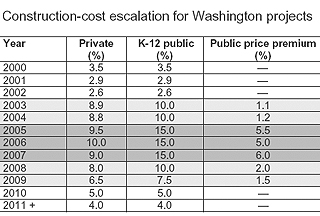|
Subscribe / Renew |
|
|
Contact Us |
|
| ► Subscribe to our Free Weekly Newsletter | |
| home | Welcome, sign in or click here to subscribe. | login |
Construction
| |
 |
September 20, 2007
Public school projects fall out of favor with bidders
Rider Levett Bucknall

Squire
|
Construction pricing is heavily dependant on market economics.
In a hot market where demand far exceeds supply, contractors and subcontractors have the ability to be more selective in the projects they choose to bid on. This situation has been occurring since the last quarter of 2003 in the Northwest. Moreover, in the last two years this has been felt more strongly by the public sector than the private sector.
With the market conditions understood, why are some projects being competitively bid and others are not?
The answer to this simple but important question is based on the “attractiveness” of the project. Subcontractors and general contractors look at various factors when considering a project prior to diving in.
The following categories are generally the main areas that are initially reviewed, and can either attract or detract potential suitors:

• Public versus private. Simply put, public projects require additional requirements compared with private projects. These additional requirements are not attractive to contractors and may deter them from considering the project.
Historically, public projects have been attractive to the market where the private workload is unable to support the market. During these times both public and private projects provide a balance of work and guaranteed payment from public projects.
However, in a hot market, public projects are less attractive and bidders prefer not to pursue them. In reviewing construction-cost escalation since 2000 for K-12 schools, the spike in construction activity has coincided with the jump in escalation. The escalation for K-12 schools ranges from 1 percent to 5 percent above private-project escalation.
The table on this page sets out escalation for public versus private projects in the state of Washington. Looking ahead, it’s anticipated that the current premium imposed on public projects will continue throughout 2008, after which it’s expected to align itself with private work.
•Bidding process. With contractors being busier than they can remember, they are looking for the most attractive delivery method to entice them into the bidding race.
The traditional method of a lump sum historically used in less buoyant markets is not attracting as many contractors as the negotiated bid arrangements.
• Reputation of design team. The architect and subconsultants assembled for each school project will produce a level of documents that can vary from exceptional to acceptable to subpar.
Design firms generally have a level of quality that each company has decided it needs to attain as part of its business plan. The quality of design can be hampered if the level of work in a design studio is too great for the number of staff. Some design firms are able to create a niche level of design through careful selection and management of their projects.
The attraction is due to numerous reasons, including quality documents, fewer addendums, well-thought-out design details, less ambiguous drawings, tailored specifications and pleasant staff.
This is known and understood by the contractor community. The more reputable design firms attract a healthier field of construction firms. This generally leads to a tighter bid spread.
• Location. A project’s proximity to the contractors’ locality of focus is a factor in whether or not they are interested in providing a bid, or more important, a competitive bid.
A contractor operating in a hot market is not interested in traveling outside it to chase work. This is evident with “city” contractors not pursuing work in the more rural, less populated areas. Previously in slower construction markets, idling “city” contractors have used the rural regions to maintain their workforce and profitability.
The location factor has extended its reach to the Seattle and Bellevue regions. Subcontractors are being deterred from bidding on work where staff would be required to travel extensive distances to attend sites. Such travel would lengthen the work day and decrease the project’s attractiveness.
• Prestige. From time to time, contractors look for the ability to work on prestigious projects. Prestigious work can be offered at a lower rate of profit for the sole purpose of setting contractors up for future projects.
• Repeat work. The opportunity for repeat work has the effect of lowering a contractor’s pricing in order to maintain the client and work crews.
Construction markets that have been busy for long periods don’t lend themselves as a whole to this type of mentality. Repeat work is a key for any company over the long term, and it’s expected that this incentive will start to become more important in 2008.
Is it time to change the bidding system used?
Perhaps — it’s a valid question in any market. But it should be considered as part of the bigger picture. That is, how do we improve the attractiveness of K-12 projects? Do we simply modify the delivery method every time the market shifts? No!
The question should be, What makes your project more attractive?
Simon F. Squire is a principal at Rider Levett Bucknall, a global cost and project management consultant with over 60 offices.
Other Stories:
- Cascadia college building will be green inside and out
- Owners, designers can harness the Web too
- ‘I wish I could go to a school just like this’
- Light ‘chimneys’ cool off Tacoma school
- Performing arts spaces gain sophistication
- Lynnwood a proving ground for green schools
- Spokane takes a chance on GC/CM
- Seattle gets creative to expand bidding pool
- Case for operable windows isn’t open and shut
- Tomorrow’s schools will be greener, freer


